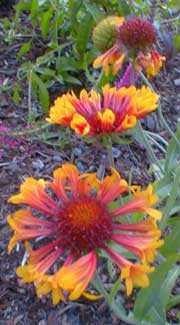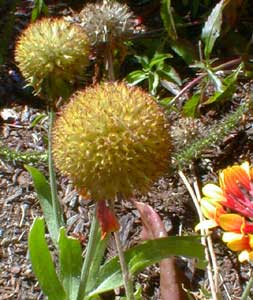
'Fanfare'
Blanket Flower
"Where have all the flowers gone
Long time passing
Where have all the flowers gone
Long long time ago
Where have all the flowers gone?
Girls have picked them every one
When will they ever learn?
When will they ever learn?"
-Pete Seeger,
b. 1919
b. 1919
Gaillardia x grandiflora 'Fanfare' is a hybrid Blanket Flower, a cross between two North American native wildflowers, G. aristata & G. pulchella. 'Fanfare' was developed in Sussex & first marketed through the Farplants nursery collective in the UK. It is only quite recently (in 2003) available in the USA, but by 2005 already something of a standard offering in independent Northwest nurseries.
During its first field trials, it was already being rumored for release in 2005, but performed so well & had such obvious commercial possibilities that it was fast-tracked for production. The target date for release in the USA was July 2003, but it turned up a month sooner than that in a local nursery, & I obtained two one-gallon pots of it at first sight.
 It was first discovered by Richard Reed in 1997 as a sport either of the hybrid cultivar G. x grandiflora 'Dazzler,' or of 'Goblin,' the uncertainty arising from not having been planned. The sport appeared spontaneously in a garden in Pagham, West Sussex (anything from Pagham has just got to end up in Paghat's Garden too).
It was first discovered by Richard Reed in 1997 as a sport either of the hybrid cultivar G. x grandiflora 'Dazzler,' or of 'Goblin,' the uncertainty arising from not having been planned. The sport appeared spontaneously in a garden in Pagham, West Sussex (anything from Pagham has just got to end up in Paghat's Garden too).My first two clumps died out of the garden after one good year. I'd perhaps had them in much too rugged & dry a location, for even drought-tolerant plants have their limitations, but I was never quite sure why they didn't perennialize. A year or two later I installed a patch in a friend's garden wehre I was doing some landscaping, in a sunny spot that got moderate watering in well-draining organically rich soil.
'Fanfare' possesses vibrant, large (over three inches), & rather strange flowers. Gaillardia blossoms give the general impression of unusually bright pumped-up daisies, & 'Fanfare' is more than usually bright. On closer examination, one realizes that each radiating petal is actually a distinct trumpet-flower.
In Northwest gardens it begins blooming by June, & continues until first frost of September or October. As each flower ages & drop their petals, there remains a coneflower-like seedhead which has its own charm, & can be snipped off as they wear out to keep the clump reflowering.
The clumps grow a foot or a foot & a half tall, & will spread about as wide. They are sufficiently cold-hardy to be grown down to zone 6, or 5 with winter mulching & protection. In Zones 7/8 it is semi-evergreen for its basal foliage, but should be trimmed back mid to late winter.
Gaillardia hybrids are shortlived even if they perennialize for a couple of years, but can be further propogated either by seed or cuttings. They are in general not susceptible to disease, but crowding & poor air circulation can attract powdery mildew, & poorly draining soil or heavy winter rains, or overwatering in summer, will result in rootrot & the clump's disappearance from the garden. In conditions greatly to its liking, it might naturalize without further attention.
But even if it is grown as a defacto annual, its performance is worthwhile for its extremely long blooming time. It attracts hummingbirds to the flowers & finches to the seedheads, & is a favorite of butterflies & bees.
The common name Blanket Flower is believed to have arisen as a reference to Native American rug weavings of the American Southwest, which used similar colors. So it was also called Indian Blanket. A romantic legend, undoubtedly originated by white settlers, tells of an Indian child lost on the prairie. As the sun was going down, she became cold & afraid, & asked the Great Spirit to provide her with a blanket. When she awoke at dawn, she was covered over with flowers that were the same colors as her mother's weavings.
But it has also been suggested the name arose from the density of its flowers so that a colony of gaillardia formed a continuous blanket of blooms. It's also known as Firewheel, Bandana Daisy, Sunburst, or Sundance Flower.
According to Aztec legend, gaillardia was originally only yellow, but with the murderous arrival of the Conquistadores, the flower felt sadness for over Aztec blood so freely spilled, & added red to its petals to honor the slain.